فهرست مطالب

Journal of Iranian Medical Council
Volume:4 Issue: 3, Summer 2021
- تاریخ انتشار: 1400/07/20
- تعداد عناوین: 12
-
-
Pages 115-124
Saffron or crocus sativus L. (C. sativus) has been widely used as a food additive as well as a therapeutic agent in traditional medicine for centuries, especially in Asian countries. This spice consists of three bioactive components, including picrocrocin, safranal, and crocin, which exert alleviating effects in a wide range of disorders (e.g.cardiovascular, respiratory, gastrointestinal, neurodegenerative, psychiatric and female-specific disorders). Anti-nociceptive, anti-inflammatory, and anti-oxidative characteristics were reported for this herbal agent. Additionally, several studies have addressed the potential role of saffron in modulating the serotonergic system, which could be helpful in treatment of some diseases specific to women such as Premenstrual Syndrome (PMS), Postpartum Depression (PPD), postmenopausal symptoms, and sexual dysfunction. Nowadays, use of herbal medicine instead of chemical prescriptions has become very popular due to their generally lesser side effects and cultural acceptability. In the present report, we provided an overview of the current literature regarding the potential effects of saffron on women’s health. Taken together, saffron seems a spice with strong beneficial impacts on various aspects that a woman might challenge with. Further trials could pave the way for the introduction of saffron as a routine safe treatment of aforementioned conditions in women population.
Keywords: Female-specific disorders, Premenstrual syndrome, Postmenopausal symptoms, Postpartum Depression, Saffron, Sexual dysfunction -
Pages 125-136
The COVID-19 virus has caused many deaths of people worldwide since the pandemic began. However, no definitive treatment for this infection has been discovered so far. It has been shown that comorbidities such as diabetes, hypertension and cardiovascular diseases are associated with an increased risk of SARS-COV-2 infection. Interestingly, SARS-COV-2, like SARS-COV, uses the ACE2 gene to enter the host cell. Also, changes or imbalance in ACE2.ACE can affect SARS-COV-2 susceptibility, related outcomes and mortality. Regarding the crucial role of ACE2 protein in COVID-19 infection, the effect of different factors such as age, BMI, physical activity levels, nutritional status, altitude, as well as blood group was assessed on the level of this protein. Further, to our knowledge, no study has been conducted to examine factors that increase or decrease the risk of COVID-19 and its related severity and outcome in normal subjects emphasizing the pivotal role of ACE2. Therefore, the primary purpose of this study was to investigate the involved mechanisms of ACE2 protein and other risk factors causing infection in different situations and finally, to introduce a safe, accurate, and cost-effective approach to prevent SARS-COV-2 infection and hard clinical outcomes in normal subjects.
Keywords: Blood group antigens, Body mass index, COVID-19, Nutritional Status, SARS-CoV-2 -
Pages 137-144BackgroundRoutine blood testing consists of Complete Blood Count (CBC) indices together with Comprehensive Metabolic Panel (CMP) which have significant roles in both diagnosis and prognosis of the novel coronavirus disease 2019 (COVID-19).MethodsA total number of 942 COVID-19 patients and 400 healthy persons as the control group were enrolled in this study. All patients were admitted to a single center and were divided into two groups according to disease severity (severe or non-severe). Routine laboratory findings of peripheral blood sample were collected and then analyzed.ResultsNeutrophil-Lymphocyte Ratio (NLR) had the highest sensitivity and specificity value for COVID-19 diagnosis. Among patients with different severities of COVID-19, the amount of neutrophil, NLR, platelet, hemoglobin, Red cell Distribution Width (RDW) and total bilirubin was significantly different (p<0.01).ConclusionSome indices of complete blood count and comprehensive metabolic panel have diagnostic and prognostic roles in COVID-19 patients, which are helpful in early diagnosis, predicting severity and adverse outcomes of patients with COVID-19.Keywords: bilirubin, Blood cell count, Blood platelets, Coronavirus, COVID-19, Erythrocyte indices, Hematologic tests, Humans, Lymphocytes, Neutrophils
-
Pages 145-152BackgroundMost road collisions are directly attributed to human factors. Since aberrant behaviors of drivers play a pivotal role in the occurrence of road accidents, it is worth studying driver behaviors in a riskier situation of carrying hazardous materials. This study aimed to evaluate the behaviors of the drivers carrying hazardous materials at the international border of Bashmaq-Marivan, Iran.MethodsThis descriptive-analytical study was conducted on 250 Iranian drivers carrying hazardous materials at the international border of Bashmaq-Marivan. The participants were included taking a census. Data were collected using the Manchester Driver Behavior Questionnaire (MDBQ). Data analysis was performed by SPSS v 16. The p-value of less than 0.05 was considered statistically significant.ResultsThe drivers carrying inflammable liquids had more lapses compared to those carrying inflammable gases. The drivers with less driving experience and higher driving speed had more errors, as well as aggressive and ordinary violations. Higher rates of aggressive violations and errors were detected in young drivers, while the drivers with higher rates of accidents had comparatively more lapses and ordinary violation.ConclusionConsidering the effects of age, driving experience, high speed, and accident experience on aberrant behaviors in driving, it is recommended that public training targeting specific groups be implemented regarding the legal constraints of driving.Keywords: aggression, Automobile driving, Census, Hazardous substances, Humans, Incidence, Iran
-
Pages 153-158BackgroundMultiple Sclerosis (MS) causes brain atrophy at the early stages of the disease which leads to progressive motor and cognitive dysfunction. Brain atrophy can be diagnosed indirectly by measuring the Third Ventricle Diameter (TVD) using Trans Cranial Sonography (TCS). The purpose of the current study was evaluation of TVD in MS patients using TCS to examine its possible correlation with cognitive dysfunction and Expanded Disability Status Scale (EDSS).MethodsSeventy-four patients with a definite diagnosis of MS were enrolled in this study. Transverse diameter of the third ventricle was measured using TCS. All patients were assessed by neurological examination and the level of disability was measured via EDSS. The cognitive performance was assessed by the Brief International Cognitive Assessment for Multiple Sclerosis (BICAMS). Pearson’s correlation was performed to evaluate possible correlations and p-value<0.05 was considered statistically significant.ResultsFrom the total 74 individuals, 58.1% were diagnosed with Relapse-Remitting MS (RRMS) (n=43) and 43.9% with Secondary-Progressive MS (SPMS) (n=31). The mean EDSS score was 1.81±1.38 (Range of 0-10). The mean TVD was 5.61±1.82 cm which had no statistical correlation with the EDSS score, but it was significantly wider in group with EDSS score>3 when compared to the group with EDSS score≤3 (p-value=0.0001). The mean BICAMS score was 0.65±0.57 and there was no statistical correlation between BICAMS score and TVD.ConclusionMeasuring the diameter of the third ventricle using TCS appears to be an appropriate method to diagnose brain atrophy and is associated with cognitive dysfunction in the process of MS. Our data emphasized no association between the diameter of the third ventricle and cognitive dysfunction.Keywords: Cognitive dysfunction, Humans, Motor disorders, Multiple Sclerosis, neuroimaging, Third ventricle
-
Pages 159-164BackgroundChronic Obstructive Pulmonary Disease (COPD) leads to limited activity and reduced quality of life. Treatment of this disease is a long-term process that requires the cooperation of patients in monitoring and treatment.MethodsIn the present study which was conducted from April 2019 to March 2021 in Masih Daneshvari Hospital, Tehran, Iran, 75 patients were randomly divided into telerehabilitation and control groups. Patients in the control group received pulmonary rehabilitation including respiratory, isometric, and aerobic exercises for 8 weeks, three times per week. In the second group, patients were given a lung rehabilitation booklet and asked to repeat the exercises three times a week for four weeks according to a specific schedule. In addition, patients installed Behzee care application on the mobile phone that recorded various indicators such as heart rate, SpO2, dyspnea, fatigue, and daily activities. This application reminded the patient of the program every day and at a specific time. Finally, the patients’ conditions were compared in the two groups after 8 weeks using CAT and mMRC questionnaires and 6-Minute Walk (6MW) exercise indices as well as spirometry tests.ResultsIn all four indicators (6MW, CAT, and mMRC questionnaires as well as spirometry), patients showed improvement after rehabilitation (p<0.001). This improvement was significantly higher in the telemedicine group compared to the other group (p<0.01).ConclusionThe use of telerehabilitation in COPD patients is effective in improving spirometry indices, quality of life, as well as activity and sports indices.Keywords: Chronic Obstructive Pulmonary Disease (COPD), Telerehabilitation, Pulmonary rehabilitation, Spirometry
-
Pages 165-172BackgroundMultiple-choice questions are among the most common written tests. This study aimed to evaluate the faculty members’ability to determine and predict the level of difficulty and discrimination coefficient of multiple-choice tests at Psychiatry Department.MethodsAll faculty members at Psychiatry Department of Iran University of Medical Sciences participated in this study. The difficulty and discrimination coefficient of all questions (150 questions) of the mid-term exam of psychiatric residents were measured with both software program and formulas by hand. Then, from each group of questions with high, medium, and low difficulty coefficient, 10 questions (30 questions in total) were selected and provided to faculty members for ranking each question in terms of difficulty and discrimination coefficient. Finally, the correlation between faculty members’ evaluation and standard results was measured by the Spearman’s correlation. To calculate the discrimination coefficient, the number of people who answered a question correctly in the low-score group was subtracted from the high-score group and then the result was divided by the number of people in a group.ResultsTwenty-five faculty members participated in this study. There was a significant negative correlation between difficulty level and discrimination coefficient in the whole group (r=-0.196, p=0.045), but this was not the case in the upper and lower groups (r=-0.063, p=0.733). In addition, the correlation between the discrimination coefficient obtained from the formula and the average discrimination coefficient of faculty members was not significant (r=-0.047, p=0.803).ConclusionIt seems that the ability of faculty members to predict the discrimination coefficient and difficulty level of questions is not sufficient.Keywords: Education, Educational measurements, Medical, Psychiatry, Reference Standards
-
Pages 173-182BackgroundSilymarin and N-acetylcysteine are antioxidant supplements with protective effects on the liver and kidneys. The aim of this study was to investigate the effect of silymarin and N-acetylcysteine on liver and kidney disorders against severe pre-eclampsia.MethodsIn the present single-blind clinical trial, 60 mothers who underwent termination of pregnancy due to severe pre-eclampsia were divided into two groups. The first group received 70 mg of silymarin and the second group received 600 mg of N-acetylcysteine at 3 doses immediately, 12 and 24 hours after delivery. Patients were monitored for blood pressure, platelet and biochemical markers of liver injury and kidney function 12, 36 and 60 hours after drug administration.ResultsOver time, the mean Alanine Transaminase (ALT), Aspartate Transaminase (AST), Lactate Dehydrogenase (LDH) and Alkaline Phosphatase (ALP), levels in the two groups of silymarin and N-acetylcysteine significantly decreased (p<0.001). Silymarin and N-acetylcysteine were not significantly different in reducing the increased creatinine and BUN levels.ConclusionN-acetylcysteine and silymarin help patients with pre-eclampsia to improve kidney and hepatic dysfunction; however, silymarin was more effective in decreasing ALT, AST, ALP, and LDH levels than N-acetylcysteine. N-acetylcysteine was more effective in decreasing BUN and creatinine levels than silymarin.Keywords: Kidney, N-acetylcysteine, Pre-eclampsia, Silymarin
-
Pages 183-185


